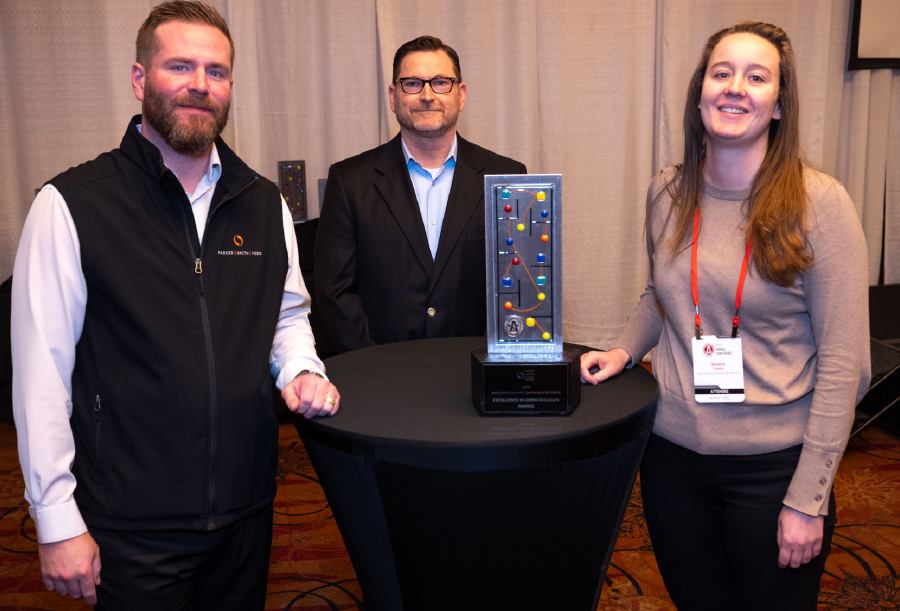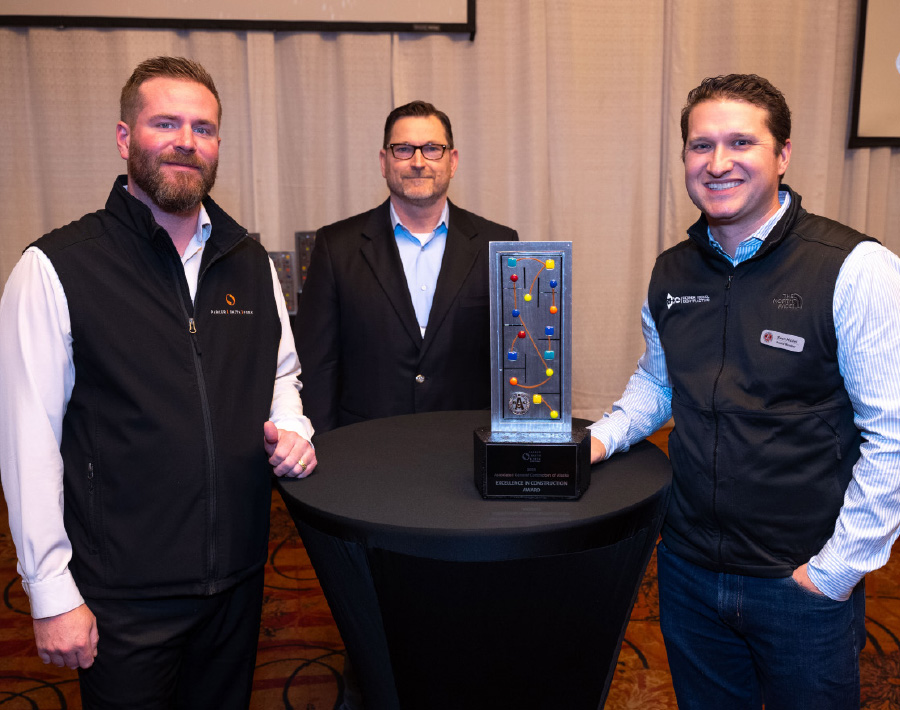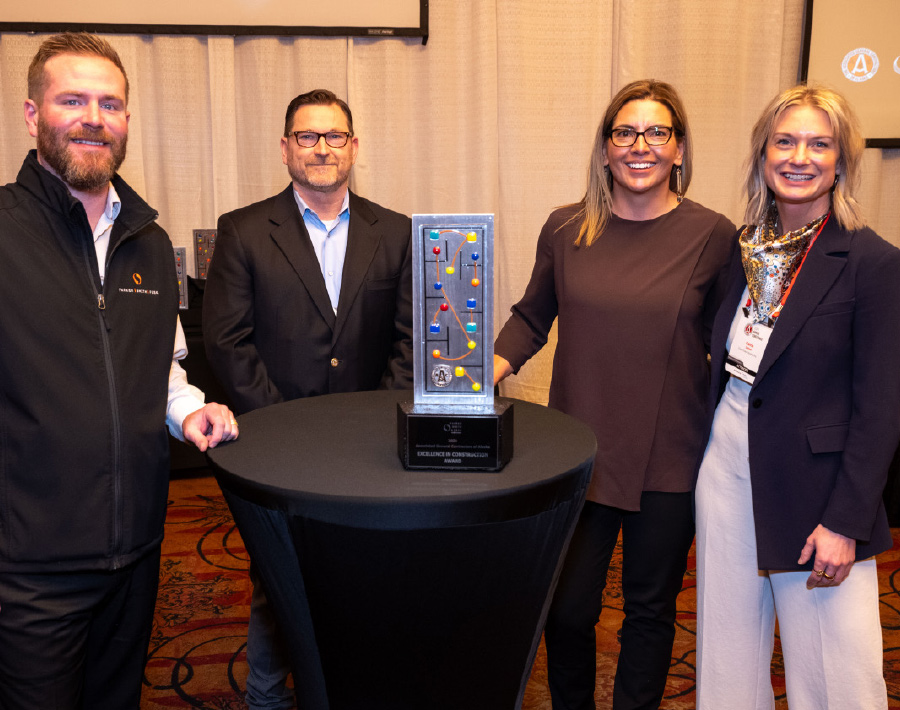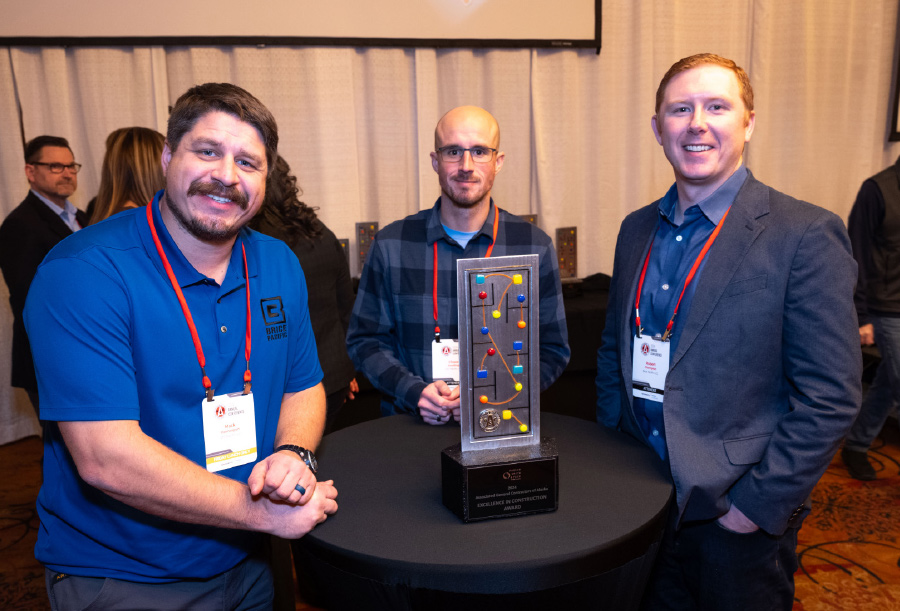
t takes a different approach to work in construction in Alaska. The challenges that roads, facilities, or environmental remediation present are unlike those in any other state. Weather, geography, and a lack of basic infrastructure requires innovation, resilience, and a unique set of skills.
“Any successfully completed construction project is monumental these days in its own right. You have to deal with workforce challenges—[that’s] probably one of the biggest things we hear about; weather events—that’s getting more and more unpredictable—and obviously, schedule delays invoked by others. Those are probably the biggest things I have heard in the last couple of years that you all deal with on a daily basis,” said Lynne Seville, vice president and account executive of Parker Smith & Feek, on November 8 as she prepared to announce the winners of the Excellence in Construction awards.


t takes a different approach to work in construction in Alaska. The challenges that roads, facilities, or environmental remediation present are unlike those in any other state. Weather, geography, and a lack of basic infrastructure requires innovation, resilience, and a unique set of skills.
“Any successfully completed construction project is monumental these days in its own right. You have to deal with workforce challenges—[that’s] probably one of the biggest things we hear about; weather events—that’s getting more and more unpredictable—and obviously, schedule delays invoked by others. Those are probably the biggest things I have heard in the last couple of years that you all deal with on a daily basis,” said Lynne Seville, vice president and account executive of Parker Smith & Feek, on November 8 as she prepared to announce the winners of the Excellence in Construction awards.

ASKW-Davis, LLC, a joint venture between ASRC SKW Eskimos and Davis Constructors and Engineers, received the “Meeting the Challenge of a Job, Over $15 Million: Vertical Construction” award for building the Yukon-Kuskokwim Qavartarvik Customer Lodging Building. Alcan Electrical & Engineering won the “Excellence in Construction Award for a Specialty Contractor for a Job Over $5 Million” award for its work installing state-of-the-art electrical systems in the facility.
The project is important to the region. With limited housing available in Bethel, patients and family members from neighboring villages have few options for housing while they’re being treated. This facility, with 109 rooms, a restaurant, and other support functions, quadruples the hospital’s capacity to house patients and family members and is designed with future expansion in mind.
Kevin Clark, Davis project manager for the customer lodging building, says the project was unique in that it was built with heavy gauge metal studs and floor joists, coupled with steel brace bays and support columns, which afforded very little flexibility in terms of coordinating the work.
“ASKW-Davis decided that not only would we need to generate a 3D coordination model for the MEP (mechanical, electrical, and plumbing) systems but also every single metal stud, floor joist, and framing member. We then worked to design all of the wall and floor sections into manageable panels that could be prefabricated onsite. We constructed an onsite prefabrication building out of 40-foot containers and recycled roof trusses, complete with fabrication tables and a tracked hoist assembly. Not only did this allow us to accelerate the schedule by being able to build these sections concurrently with the pile installation, but significantly reduced safety risks from stick framing these components at height and in inclement weather,” Clark says.
Clark says winning the award “provides recognition for the efforts and sacrifices made by all parties involved to bring this project to fruition.”
“Everyone on the project team worked hard to provide the highest quality project for our client and the Western Alaska communities the facility now serves,” he says.
Chrys Fleming, president of Alcan Electrical & Engineering, says the unique challenges of Bethel required his company to design an advanced energy-efficient system and backup power, which made the project “technically innovative and impactful.” The project included energy-efficient lighting, emergency power systems, and advanced electrical panels that can withstand the harsh environmental conditions in Bethel.
Fleming says Bethel’s remoteness added logistical and climate challenges to the project, “but strong coordination with ASKW-Davis allowed us to keep everything on track.”



“Winning this award is an honor that showcases Alcan’s commitment to high-quality work in Alaska’s toughest environments. It strengthens our reputation and motivates us to continue innovating,” Fleming says.
The Shageluk project was initially intended to be a small-scale resurfacing project, but site observation showed the airport access road had recurring flooding and erosion problems. Additional study resulted in significant change orders, leading to the project cost increasing by more than 40 percent. Undocumented pit homes were discovered near the project, requiring cooperation with the community and archaeologists to identify, delineate, and protect the sites during construction. In addition, what began as a “recondition and resurface” job became much more intensive upon discovery that the previous alignment was built with organic materials, clay, silt, and sand.
“Cruz’s articulated 6-wheel drive haul trucks were barely able to operate, sinking into the flooded surface without sufficient subgrade to drive on,” Cruz officials noted in a narrative about the project, which led to a new embankment design. Then a spring flooding event kept the site submerged for several weeks at what would have been the start of construction. Cruz pivoted and used the Innoko River’s high water level to its advantage, creating new barge access points along the project route to stockpile aggregates and explosives that the contractor would need throughout the construction project. Ultimately, Cruz delivered more than twice the expected cubic yards of borrow for the project, among other changes, and left the community with three new river access points, along with a one-acre staging pad for local use and a small approach to a community garden that had become unreachable due to flooding.
The Atqasuk Airport project, located on the Meade River about sixty miles south of Utqiaģvik, posed a whole different set of challenges. There, the harsh winter had led to additional maintenance that scraped away the runway’s surface, leaving the village’s 5,000-foot runway uneven and exposing the unstable subsurface.
Lacking any suitable material sites nearby, Cruz barged aggregate and E1 gravel to Nome and then hauled it to the site using specialty 40-ton dump wagons fitted with low ground-pressure tires, traveling over winter trails. Although the company expected to need two winters to haul the roughly 35,000 tons of aggregate, equipment, materials, and fuel, Cruz was able to complete it in one with no reports of tundra damage and no need for permanent infrastructure. The company delivered gravel unusable for the project to the community landfill, where it was used to cover waste. Six local residents were hired for the project, and Cruz partnered with Atqasuk Corporation to rent and improve existing housing in the village, reducing the need for temporary facilities and expanding the village corporation’s ability to offer lodging to visitors.


“Our mission statement states: ‘The core foundation of Cruz Construction has been to honestly outwork the competition, as we humbly empower those around us and hold each other accountable.’ Excellence takes a daily grind as it requires every one of us to own our responsibilities while we help our brother and sister out,” Miller says.
Cruz is honored to be recognized by AGC, an organization the company is proud to be part of.
“Through AGC we have gained valuable relationships and friendships that help make us a more informed and a better Alaskan contractor. So, to win an award pertaining to ‘Excellence in Construction’ amongst a group of over 100 of Alaska’s best general contractors is a very high honor,” Miller says.
“It was challenging because we had to replace the CT machine, so we had to facilitate getting that out of there and getting the new one in,” said Roger Hickel Contracting President Sean Hickel. “The MRI had to be left in place, and we didn’t deenergize it until a certain time, so working around a big magnet can be fun. You can’t have any metal tools.”
Hickel says the team left the MRI machine until last so the hospital could leave it in use, then quickly got the new one in place.
The work environment—a busy hospital—posed another significant challenge.
“The most challenging aspect of this project from a management perspective was the sensitivity of working simultaneously with hospital staff and patients to limit disruptions to their daily operations during construction activities,” Roger Hickel Contracting officials wrote in the award submission. “To be as minimally invasive as possible, RHC constructed temporary walls and dust barriers around the tight working quarters and set up air hogs to scrub the dirty construction air, clean it, and discharge it outside of the critical hospital patient zones.”
Hickel says he enjoys the friendly competition the Excellence awards provide.
“We’ve been an AGC member for a long time, and I think the Excellence in Construction and safety awards are a really positive thing to get awareness of projects and the struggles we go through and all the work we’ve put in to these projects,” he says.
Cape Prince of Wales is the westernmost point of land in North America, forming the western tip of the Seward Peninsula. The Naval Field Station there was last active in 1978. The buildings on the property were abandoned in 2000. ChemTrack was hired to remediate, demolish, and remove the structures for the global engineering firm Jacobs on behalf of the US Navy. It did so, encountering several problems along the way, from a road to the site that was impassable upon arrival to a temperamental loader that slowed the process of moving materials from the barge delivery point about 10 miles from the project site. Unanticipated subsurface cables were found on the site that, left intact, posed a health hazard to the locals who use the beach regularly. The cables, World War II submarine trackers, were followed to the ocean and cut during low tide, with the ends buried. ChemTrack found asbestos in the floor of a building that was presumed to have a dirt floor, so the company sought and received approval to perform abatement without losing time on the primary project. ChemTrack discovered asbestos and lead-based paint in several of the buildings—it recorded more than 23 tons of lead-based paint or wood debris removed from the site and more than 4 tons of asbestos-containing material debris.



“I think that’s the biggest reward for everybody. The part that I love is, our people love it—the people who work for us, the site super, they request these projects, they want to go and see the difference it’s made. And it’s very satisfying at the end, to see the before and after, both for the community and for our folks as well,” she says.
In May 2022, a fire started in the old generator house for the school. It spread to the principal and teacher housing, ultimately destroying three buildings and leaving smoke residue throughout the school.
Ahtna secured the contract to clean up the extensive fire damage. Ahtna was also asked to strengthen the roof, which had been affected by heavy snowfall, and later to demolish and rebuild the gym to make it usable for the following school year.
Ahtna officials, in the award submission, said well-timed material deliveries made a big difference for the project. The school, in Kasigluk, is at the end of the 55-mile ice road from Bethel. The project site superintendent, having grown up in Bethel, knew the road would be in its best shape for a basketball tournament, so they used that timeframe to bring equipment to the school site. To stabilize a crane without damaging sensitive tundra, the superintendent tasked the crew to create a foundation for the crane by stacking heavy oak mud mats on top of insulation pads. The team later installed the mats in the children’s play area to increase their play space. Other community benefits included creating a “reclaim/reuse” area for leftover material from the demolition, and Ahtna crews offered transport to teachers to Bethel when room in company vehicles was available.
“As an Alaska Native-owned firm, Ahtna understands and honors the cultural significance and importance of this facility,” Ahtna officials wrote in the award submission. “Schools are the center for most community activities. The community embraced our presence because they knew Ahtna was there to restore their school.”
About winning the award, Ahtna Senior Business Development and Marketing Group Manager Lori Kropidlowski says it’s a good boost for the crew that worked on the project.
“It takes a solid staff to execute these challenging projects in remote locations. We’re really proud that our team pulled it off,” she says.
“The project was originally slated to be a March installation, but because of permits it got pushed until June, but we needed to achieve freeze-back for the pilings. That’s harder to do in the summertime, so we worked with our design team and came up with installing dry ice in the bottom of [each] pile. It froze back extremely quickly. To our knowledge it’s the first time that’s been done. We have not used that [technique] before and it worked really well,” STG, Inc. President Brennan Walsh says.
Walsh says it was a solution with a ticking clock: dry ice only has about a four-day shelf-life. STG, Inc. coordinated with Airgas to fly the solidified carbon dioxide to the site. The foundations were prepared and ready, and dry ice was added to the slurry backfill, providing the freezing needed to stabilize the piles, keeping the project on track.
STG, Inc. then took the project a step further. The project scope was initially just to install the new tower, and at a later time the client would put the new tower into service and remove the old tower. However, STG found a way to keep the communication service working while taking down the old tower.
“This is known as a ‘hot’ crossover, without losing service. STG’s value-added solution expedited service delivery for the client while also saving time and money,” STG officials noted in the award submission.
These innovations won STG, Inc. the “Excellence in Construction Award for a Specialty Contractor for a Job Under $1 Million” award for the Utqiaġvik Airport New Telecommunications Tower Facility.

The project objective was to install new culverts at three stream crossings along Skilak Lake Road, while also improving road alignment and stabilizing the road bank. However, the work needed to happen while the one-lane road remained open to the public throughout construction.
“In the summer, it’s very busy with fishing. We were obligated to keep the road open for the duration of the project, and it’s already a one-lane project to begin with, with wetlands on both sides, so you’re trying to replace a culvert—which basically displaces the entire road section and then some—and then build it all back, all while people were trying to get through,” STG Pacific Preconstruction Manager Chase Swalling says.
Further complicating matters, he says, the crew realized that materials at site were unsuitable, so a plan to re-use them was scrapped. STG Pacific trucked in three times the amount of material that was anticipated to an already congested work site.
In short, it was a difficult project, but the team persevered. Swalling says receiving an award for the effort is a nice bonus.
“I think it’s encouraging because the team goes through the challenges of having a grueling season. To be able to overcome that and have it be recognized by others outside the group, I think it really helps to challenge them to do more of that difficult, challenging work,” he says.
The project faced several challenges, from mobilizing equipment to managing personnel. But one of the most significant was the need for the required project materials. Brice crews developed the Pilcher Mountain Quarry about 65 miles upriver from St. Mary’s, where company officials say all surface course materials were produced and shipped by barge to the airport site.
Read more about the St. Mary’s Airport project on page 92.
Brice, Inc. Project Engineer MaLinda Malenfant says winning an award for the two-year project was satisfying.
“Personally, and for the team, it makes you feel good, validated, more confident in our project, our results and in our team,” she says.